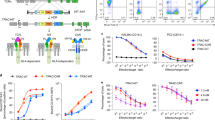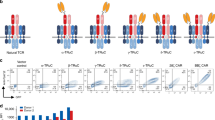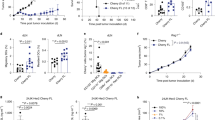Abstract
Adoptive transfer of ex vivo expanded tumor-specific T cells is a promising therapeutic modality for promoting or augmenting antitumor immunity. Several groups, including ours, are developing antigen receptor gene transfer strategies as a means of generating effector cells for adoptive therapy. Chimeric antigen receptors (CARs) have been described that use single-chain antibodies or cytokine ligands as tumor targeting domains. Here, we describe the capacity of a tumor-binding peptide identified by phage display combinatorial library screening to serve as a CAR targeting domain. A phage library-selected high-affinity 12-mer peptide (Bpep) specific for alpha(v) beta(6) integrin (αvβ6) was chosen for these studies. Primary human T cells were genetically modified to express the Bpep-CAR consisting of an αvβ6-specific peptide and human IgG4 hinge-Fc extracellular domain fused to the cytoplasmic tail of CD3-ζ. T cell expression of the Bpep-CAR was assessed by Western blot analysis, and trafficking of the Bpep-CAR to the cell surface was demonstrated by flow cytometry. Functionally, Bpep-CAR redirected cytotoxic T lymphocytes specifically kill integrin αvβ6+ ovarian tumor targets, and are activated for interferon gamma secretion. Our data suggest that large new repertoires of tumor-specific T cell antigen receptor transgenes might be available through merging combinatorial peptide libraries with CAR construct design.
This is a preview of subscription content, access via your institution
Access options
Subscribe to this journal
Receive 12 print issues and online access
$259.00 per year
only $21.58 per issue
Buy this article
- Purchase on Springer Link
- Instant access to full article PDF
Prices may be subject to local taxes which are calculated during checkout





Similar content being viewed by others
References
Dudley ME, Wunderlich JR, Robbins PF, Yang JC, Hwu P, Schwartzentruber DJ et al. Cancer regression and autoimmunity in patients after clonal repopulation with antitumor lymphocytes. Science 2002; 298: 850–854.
Cooper LJ, Kalos M, DiGiusto D, Brown C, Forman SJ, Raubitschek A et al. T-cell genetic modification for re-directed tumor recognition. Cancer Chemother Biol Response Modif 2005; 22: 293–324.
Jensen MC, Clarke P, Tan G, Wright C, Chung-Chang W, Clark TN et al. Human T lymphocyte genetic modification with naked DNA. Mol Ther 2000; 1: 49–55.
Rossig C, Bollard CM, Nuchtern JG, Merchant DA, Brenner MK . Targeting of G(D2)-positive tumor cells by human T lymphocytes engineered to express chimeric T-cell receptor genes. Int J Cancer 2001; 94: 228–236.
Ren-Heidenreich L, Hayman GT, Trevor KT . Specific targeting of EGP-2+ tumor cells by primary lymphocytes modified with chimeric T cell receptors. Hum Gene Ther 2000; 11: 9–19.
Breuss JM, Gallo J, DeLisser HM, Klimanskaya IV, Folkesson HG, Pittet JF et al. Expression of the beta 6 integrin subunit in development, neoplasia and tissue repair suggests a role in epithelial remodeling. J Cell Sci 1995; 108 (Part 6): 2241–2251.
Ahmed N, Riley C, Rice GE, Quinn MA, Baker MS . Alpha(v)beta(6) integrin-A marker for the malignant potential of epithelial ovarian cancer. J Histochem Cytochem 2002; 50: 1371–1380.
Niu J, Gu X, Ahmed N, Andrews S, Turton J, Bates R et al. The alphaVbeta6 integrin regulates its own expression with cell crowding: implications for tumour progression. Int J Cancer 2001; 92: 40–48.
Kraft S, Diefenbach B, Mehta R, Jonczyk A, Luckenbach GA, Goodman SL . Definition of an unexpected ligand recognition motif for alphavbeta6 integrin. J Biol Chem 1999; 274: 1979–1985.
Alama A, Barbieri F, Favre A, Cagnoli M, Noviello E, Pedulla F et al. Establishment and characterization of three new cell lines derived from the ascites of human ovarian carcinomas. Gynecol Oncol 1996; 62: 82–88.
Cooper LJ, Topp MS, Serrano LM, Gonzalez S, Chang WC, Naranjo A et al. T-cell clones can be rendered specific for CD19: toward the selective augmentation of the graft-versus-B-lineage leukemia effect. Blood 2003; 101: 1637–1644.
Rosenberg SA . A new era of cancer immunotherapy: converting theory to performance. CA Cancer J Clin 1999; 49: 70–73, 65.
Gross G, Eshhar Z . Endowing T cells with antibody specificity using chimeric T cell receptors. FASEB J 1992; 6: 3370–3378.
Acknowledgements
We thank Mark Sherman for the Bpep-CAR modeling, and Stefanie Vernooy for creating the graphics. This work was supported in part by a grant from the City of Hope Board of Governors, Amy Philips Foundation and the City of Hope Cancer Center Grant no. 5P30 CA33572-22. The data in this paper were also presented as a poster at the 2006 SSO meeting.
Author information
Authors and Affiliations
Corresponding author
Rights and permissions
About this article
Cite this article
Pameijer, C., Navanjo, A., Meechoovet, B. et al. Conversion of a tumor-binding peptide identified by phage display to a functional chimeric T cell antigen receptor. Cancer Gene Ther 14, 91–97 (2007). https://doi.org/10.1038/sj.cgt.7700993
Received:
Revised:
Accepted:
Published:
Issue Date:
DOI: https://doi.org/10.1038/sj.cgt.7700993
Keywords
This article is cited by
-
Structural analysis of peptide binding to integrins for cancer detection and treatment
Biophysical Reviews (2023)
-
CAR T cells redirected to cell surface GRP78 display robust anti-acute myeloid leukemia activity and do not target hematopoietic progenitor cells
Nature Communications (2022)
-
Immunogenicity of CAR T cells in cancer therapy
Nature Reviews Clinical Oncology (2021)
-
CAR-T Engineering: Optimizing Signal Transduction and Effector Mechanisms
BioDrugs (2019)
-
Engineering for Success: Approaches to Improve Chimeric Antigen Receptor T Cell Therapy for Solid Tumors
Drugs (2019)



